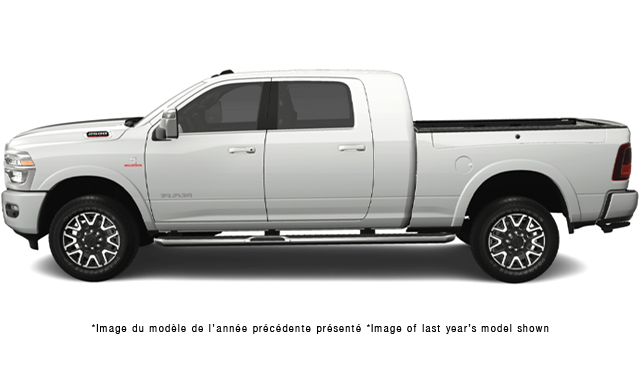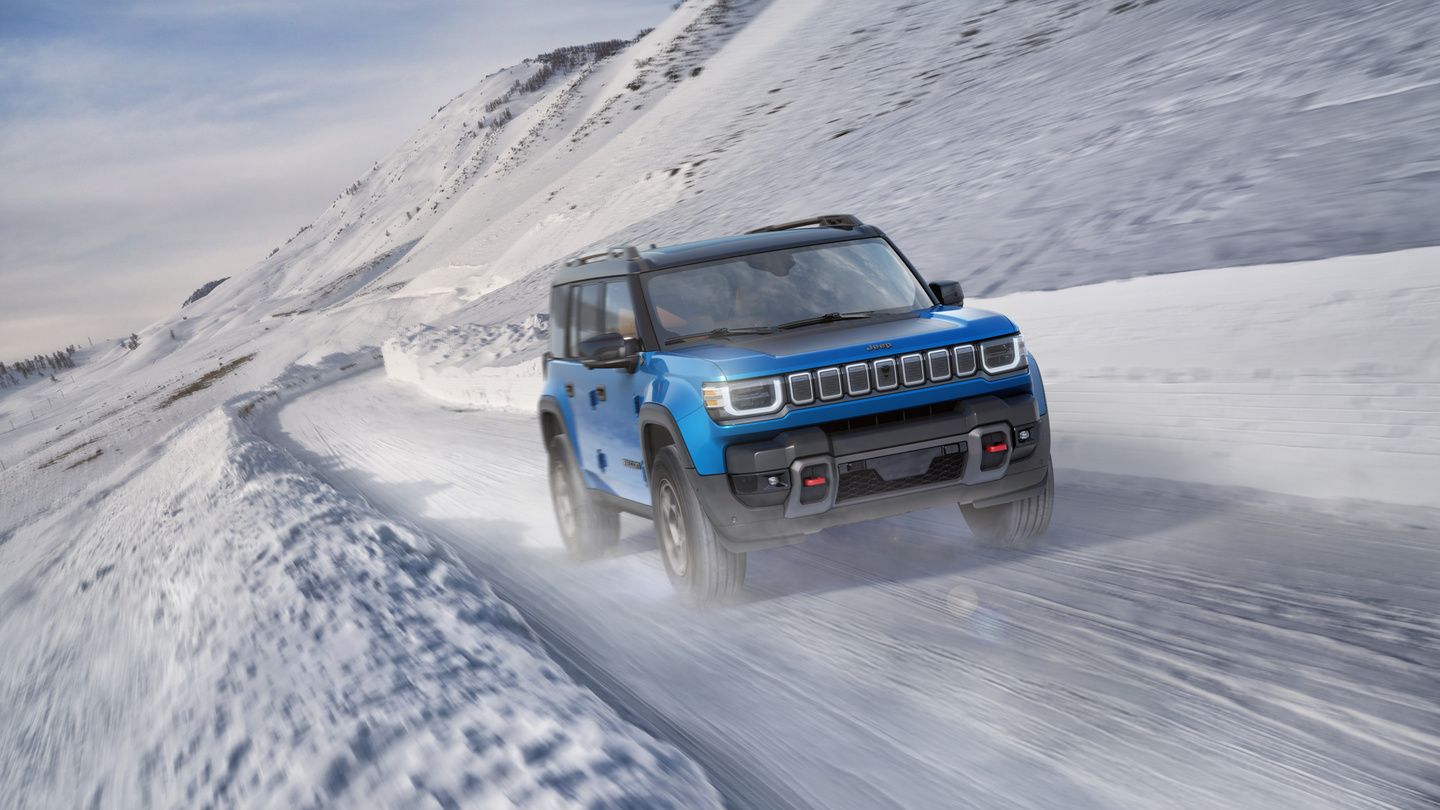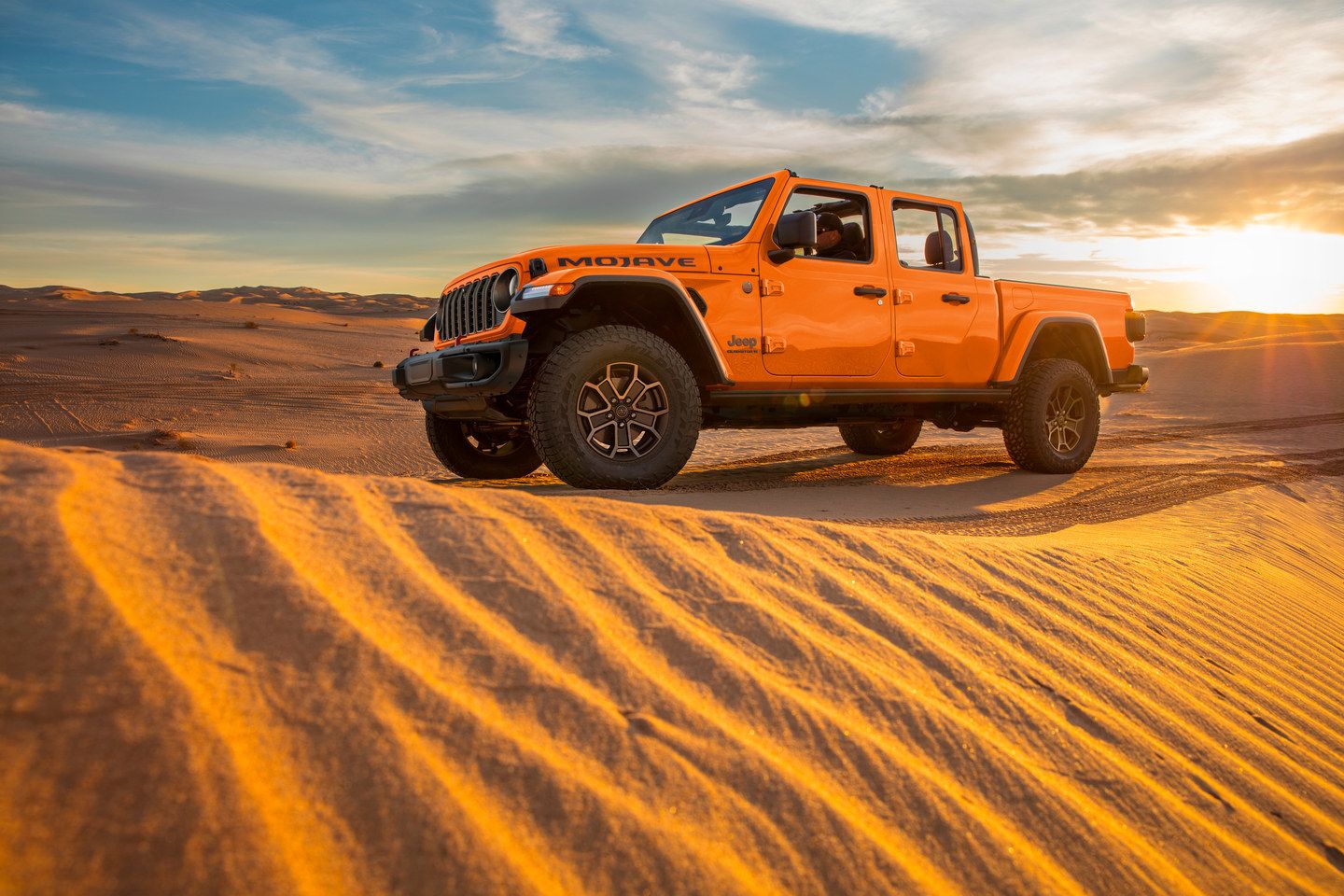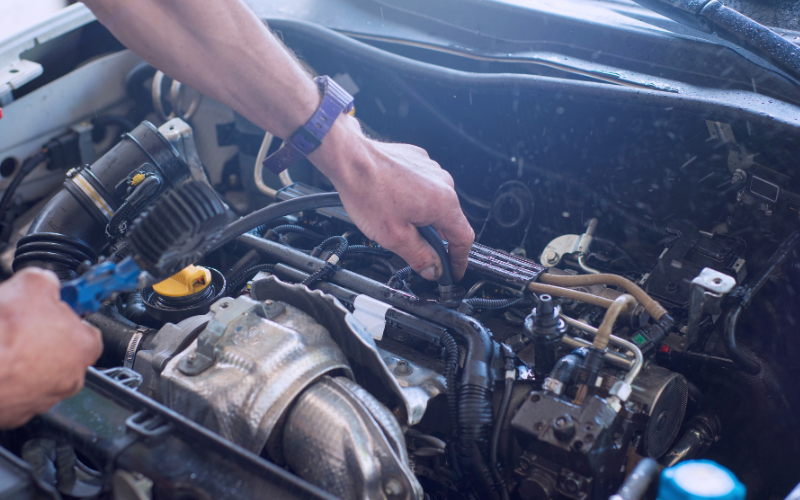Prince Albert's economy runs on diverse industries. Forestry operations haul equipment into the boreal forest. Agricultural producers move grain, livestock, and machinery. Construction crews transport materials to job sites across northern Saskatchewan. Each workload creates different truck requirements, and choosing between the Ram 1500 and Ram 2500 affects capability, efficiency, and cost of ownership.
The 2026 Ram 1500 offers the returning 5.7L HEMI V8 eTorque and Hurricane Straight-Six Turbo engines. The Ram 2500 Heavy Duty provides a 6.7L Cummins High-Output Turbo Diesel and a 6.4L HEMI V8. Both lines benefit from Ram's new 10-year/160,000-kilometre limited powertrain warranty. Understanding the differences helps Saskatchewan truck buyers match their vehicle to their actual work demands.
Quick Comparison: Ram 1500 vs. Ram 2500 Heavy Duty
|
Feature
|
Ram 1500
|
Ram 2500 Heavy Duty
|
|
Max Towing (Diesel)
|
N/A
|
16,606 kg (36,610 lbs)
|
|
Max Towing (Gas)
|
5,253 kg (11,580 lbs)
|
7,257 kg (16,000 lbs)
|
|
Max Payload (Gas)
|
1,043 kg (2,300 lbs)
|
3,443 kg (7,590 lbs)
|
|
Diesel Option
|
No
|
Yes (6.7L Cummins)
|
|
Gas V8 Option
|
Yes (5.7L HEMI)
|
Yes (6.4L HEMI)
|
|
Starting MSRP
|
Lower
|
$64,390
|
|
Warranty
|
10 years/160,000 km
|
10 years/160,000 km
|
Engine Options and Performance
Ram 1500 Powertrain Choices
5.7L HEMI V8 eTorque
The returning 5.7L HEMI produces 395 horsepower and 410 lb-ft of torque. The eTorque mild-hybrid system uses a belt-driven motor-generator unit to smooth shifts, improve cylinder deactivation efficiency, and enhance start-stop function. Towing capacity reaches 5,203 kg (11,470 lbs) with proper equipment.
This engine pairs with a TorqueFlite eight-speed automatic transmission and works with rear axle ratios of 3.21, 3.55, or 3.92. The HEMI includes a 125-litre fuel tank and comes with Ram's Symbol of Protest fender badge.
3.0L Hurricane Standard Output
The Hurricane engine delivers 420 horsepower and 469 lb-ft of torque through twin turbochargers and direct fuel injection. Maximum towing capacity reaches 5,253 kg (11,580 lbs). The engine uses advanced cooling and high-pressure fuel systems to balance power with improved fuel economy compared to larger-displacement V8s.
3.0L Hurricane High Output
Available on performance-focused trims, the Hurricane High Output generates 540 horsepower and 521 lb-ft of torque. This powertrain suits buyers who want strong acceleration and towing capability in a light-duty platform.
Ram 2500 Heavy Duty Powertrain Choices
6.7L Cummins High-Output Turbo Diesel
The Cummins diesel produces 430 horsepower and 1,075 lb-ft of torque. Maximum towing capacity reaches 16,606 kg (36,610 lbs) with the new TorqueFlite HD eight-speed automatic transmission and a 3.42 rear axle ratio. Previous model years required a 4.10 axle ratio for maximum towing, but the 2025 transmission allows peak capability with better fuel efficiency.
The diesel engine features a redesigned block and head, improved intake port geometry for top-feed injectors, integrated fuel filters, and glow plugs for cold-weather starting—important for Saskatchewan winters. The system recognizes loaded versus unloaded conditions and enables smooth second-gear starts when the truck carries no cargo.
6.4L HEMI V8
The Ram 2500's gas engine option delivers 405 horsepower and 429 lb-ft of torque. Maximum payload capacity reaches 3,443 kg (7,590 lbs). Maximum towing sits around 7,257 kg (16,000 lbs), depending on configuration. The 6.4L HEMI provides strong performance for buyers who don't need diesel torque or who prefer gas engines for maintenance simplicity.
Payload Capacity: What the Numbers Mean
Payload capacity measures how much weight a truck can carry in its bed and cabin combined. This includes passengers, tools, equipment, building materials, and any cargo. Exceeding payload ratings stresses suspension components, brakes, and tires, and creates safety risks.
Ram 1500 Payload
The Ram 1500's maximum payload capacity reaches 1,043 kg (2,300 lbs) when properly equipped. This handles many light-duty hauling needs:
- Skid of shingles (approximately 900 kg/2,000 lbs)
- Pallet of lumber (varies by species and dimensions)
- ATV or snowmobile in the bed
- Landscaping materials for residential projects
- Tools and equipment for service calls
For agricultural use, the Ram 1500 can haul seed bags, fencing supplies, or feed for small livestock operations. It works well for market garden producers or hobby farms where payload demands stay moderate.
Ram 2500 Payload
The Ram 2500's maximum payload capacity reaches 3,443 kg (7,590 lbs) with the gas engine. This capacity opens different work scenarios:
- Multiple pallets of construction materials
- Heavy equipment (small excavator attachments, compressors)
- Bulk agricultural inputs (seed, fertilizer)
- Service bodies with full tool inventory
- Livestock panels and heavy fencing materials
For construction crews building in remote locations, the Ram 2500 carries the weight of materials plus workers and tools without approaching payload limits. Agricultural operations benefit from hauling grain directly to elevators or moving multiple livestock water tanks.
Towing Capacity: Matching Trailer Weight to Truck Class
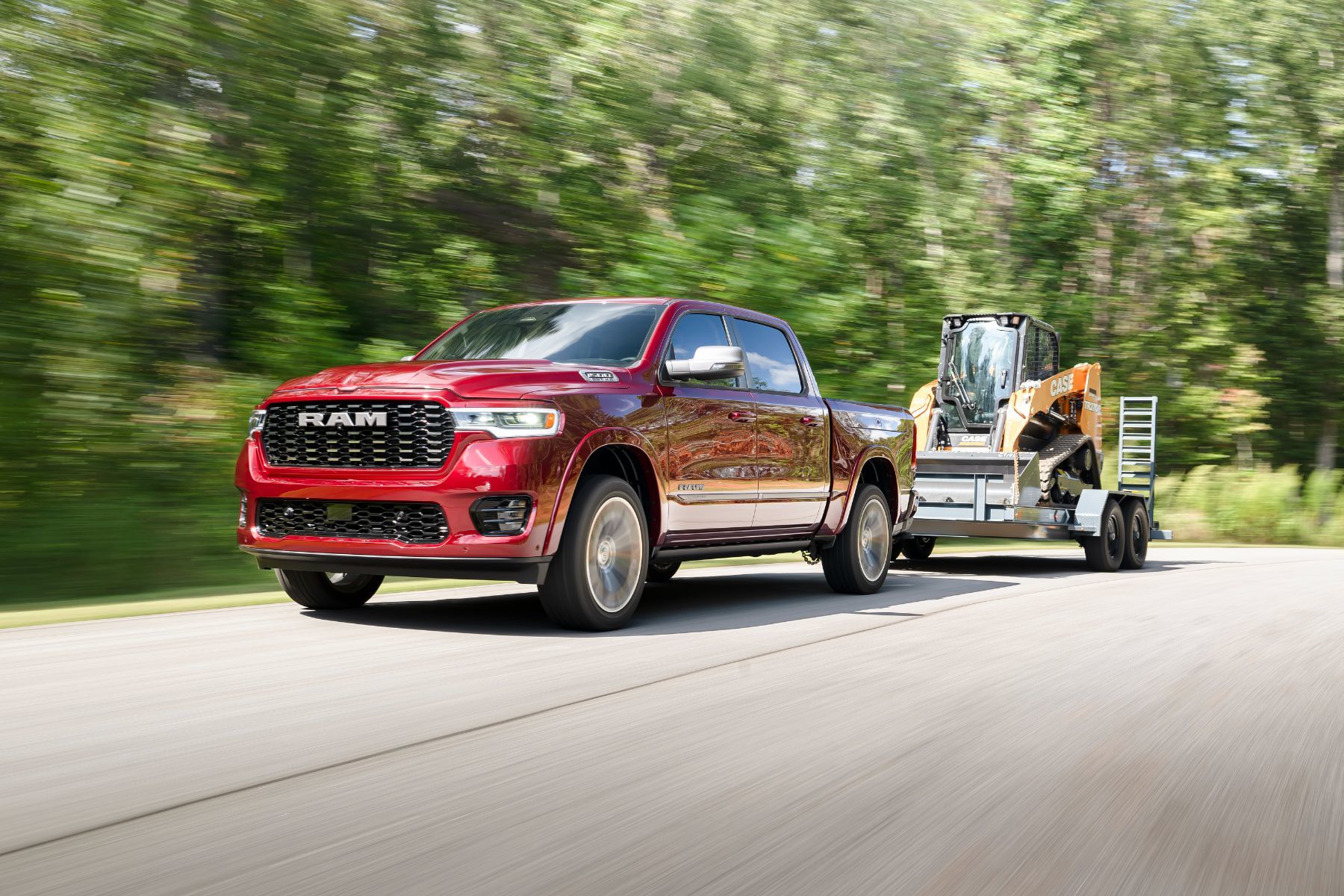
Towing capacity determines the maximum trailer weight a truck can pull safely. This includes the trailer itself plus everything loaded on it. Proper towing requires matching tongue weight to payload capacity, using the correct hitch, and configuring the truck with appropriate axle ratios and brake controllers.
Ram 1500 Towing
The Ram 1500 Hurricane-equipped models tow up to 5,253 kg (11,580 lbs). The HEMI V8 version reaches 5,203 kg (11,470 lbs). This capacity handles:
- Enclosed car trailers with a single vehicle
- Travel trailers (mid-size fifth-wheels and bumper-pull units)
- Equipment trailers with a single piece of machinery
- Livestock trailers (smaller gooseneck or bumper-pull designs)
- Boat trailers (mid-size fishing boats or recreational craft)
For Prince Albert residents heading to Emma Lake or Waskesiu with a boat, or hauling a couple of ATVs to trail systems, the Ram 1500 provides adequate towing capability. Small agricultural operations moving livestock to pasture or pulling equipment between fields work within these limits.
Ram 2500 Towing
The Ram 2500 with the 6.7L Cummins diesel tows up to 16,606 kg (36,610 lbs). This represents a substantial increase over the 1500:
- Large fifth-wheel trailers (travel trailers and RVs)
- Heavy equipment trailers (excavators, dozers, loaders)
- Multi-axle livestock trailers fully loaded
- Large enclosed trailers for commercial use
- Grain trailers
- Construction material trailers with significant loads
Forestry contractors moving equipment between cut blocks need this capacity. Agricultural producers hauling full grain loads from field to elevator benefit from the diesel's torque. Construction companies transporting heavy machinery to remote job sites require the 2500's capability.
The Cummins diesel's 1,075 lb-ft of torque delivers pulling power on steep grades and during acceleration from stops—critical when pulling heavy loads on Highway 2 between Prince Albert and Saskatoon or navigating secondary roads in northern Saskatchewan.
Fuel Economy and Operating Costs
Ram 1500 Fuel Consumption
The Ram 1500's lighter weight and smaller engines result in better fuel economy than heavy-duty trucks. The Hurricane engines deliver improved efficiency compared to traditional V8s of similar power output. The 5.7L HEMI uses cylinder deactivation and eTorque technology to reduce fuel consumption during cruising.
Real-world fuel economy depends on driving conditions, payload, towing, and individual driving habits. Light-duty trucks generally consume less fuel than heavy-duty models during unloaded highway driving and daily commuting.
Ram 2500 Fuel Consumption
The Ram 2500 consumes more fuel than the 1500, particularly with the diesel engine under heavy loads. However, the Cummins diesel's efficiency at high torque output makes it economical for towing and hauling compared to gas engines doing the same work.
The 6.4L HEMI gas option in the Ram 2500 provides an alternative for buyers who don't need maximum towing capacity and prefer to avoid diesel fuel premiums and diesel exhaust fluid costs.
For Saskatchewan operators covering high annual kilometres with heavy loads, the diesel's fuel efficiency can offset its higher initial cost and maintenance requirements. For lighter use cases, the gas engines in either truck line may prove more economical overall.
Real-World Work Scenarios
Scenario 1: Grain Hauling from Farm to Elevator
Typical Load: Grain trailer with 9,000 kg (20,000 lbs) capacity filled with wheat, canola, or barley.
Best Choice: Ram 2500 with 6.7L Cummins diesel.
The diesel's 16,606 kg (36,610 lbs) towing capacity handles full grain loads comfortably. The 1,075 lb-ft of torque maintains speed on grades and accelerates smoothly from elevator queues. The eight-speed transmission's lower cruise rpm improves fuel economy during the repeated trips between field and delivery point.
Scenario 2: Residential Construction in Prince Albert
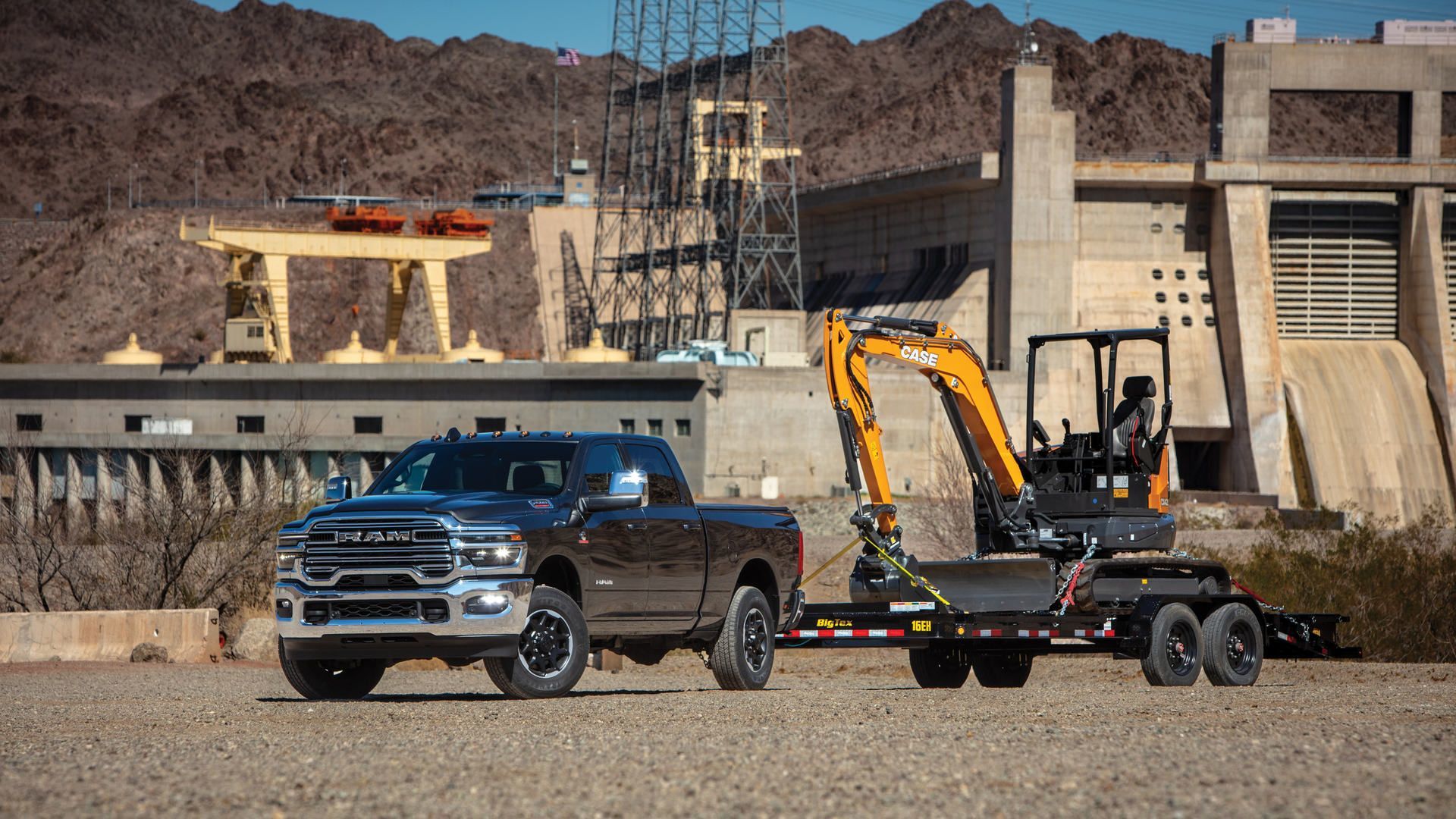
Typical Load: Tools, lumber, drywall, roofing materials. Daily towing of a small equipment trailer with a skid steer or compact excavator weighing 3,175 kg (7,000 lbs).
Best Choice: Ram 1500 with Hurricane engine or 5.7L HEMI.
The Ram 1500 handles residential construction materials within its payload capacity. Towing the equipment trailer stays well under the 5,253 kg (11,580 lbs) limit. Better fuel economy during daily driving reduces operating costs compared to a heavy-duty truck. The 1500's more comfortable ride quality benefits crews driving between job sites.
Scenario 3: Forestry Equipment Transport
Typical Load: Trailer hauling a feller buncher, forwarder, or other large forestry equipment weighing 13,608 kg (30,000 lbs) or more.
Best Choice: Ram 2500 with 6.7L Cummins diesel.
Heavy forestry equipment exceeds the Ram 1500's towing capacity. The Ram 2500 diesel provides the necessary capability and torque for moving large machinery safely. The diesel engine's durability suits the demanding conditions of forestry work, including extended idle time at remote sites and pulling heavy loads on gravel roads.
Scenario 4: Livestock Transport Between Pastures
Typical Load: Bumper-pull livestock trailer with 4–6 cattle or equivalent small livestock. Combined trailer and animal weight: approximately 4,082 kg (9,000 lbs).
Best Choice: Ram 1500 with 5.7L HEMI.
This scenario stays within the Ram 1500's towing capacity. The HEMI's torque provides smooth acceleration and maintains speed on secondary roads. Lower purchase price and better fuel economy make the 1500 the practical choice for ranchers who don't regularly haul at maximum capacity.
Scenario 5: Commercial HVAC or Plumbing Services
Typical Load: Service body with extensive tool inventory, parts, and supplies. Total payload: 1,361–1,814 kg (3,000–4,000 lbs).
Best Choice: Ram 2500 with 6.4L HEMI.
Service bodies add significant weight before tools and equipment. The Ram 2500's payload capacity handles the combined weight of a fully equipped service body plus inventory. The gas engine provides adequate power for this use case without diesel maintenance requirements. The 2500's heavier-duty suspension better supports the constant weight of a loaded service body.
Suspension, Ride Quality, and Comfort
Ram 1500 Suspension
The Ram 1500 uses a double wishbone front suspension and five-link solid rear axle with coil springs. Optional air suspension provides ride height adjustment and improved comfort. The independent front suspension contributes to better on-road handling and ride quality compared to solid front axles.
For drivers who spend significant time on paved roads between job sites or use their truck for family transportation, the Ram 1500's suspension delivers a more comfortable ride than heavy-duty trucks.
Ram 2500 Suspension
The Ram 2500 uses a three-link front suspension with track bar, coil springs, and solid axle. The rear suspension employs a five-link setup with coil springs and solid axle. This configuration prioritizes load-carrying capacity and durability over ride comfort.
The solid front axle design handles extreme stress from heavy towing and payload better than independent suspension systems. For commercial use where the truck constantly carries heavy loads, the Ram 2500's suspension maintains performance under stress that would overwhelm lighter-duty designs.
The trade-off is a firmer, less refined ride when unloaded. Buyers who primarily use their truck for work and accept a utilitarian ride quality find this acceptable. Those who want better comfort during daily driving may prefer the Ram 1500.
Technology, Towing Features, and Safety
Both Ram 1500 and Ram 2500 lines offer advanced technology and towing assistance features. Available equipment includes:
Towing Technology:
- Trailer reverse steering control
- 360-degree surround-view camera with trailer reverse guidance
- Auxiliary exterior camera for custom positioning
- Trailer tire pressure monitoring
- Trailer-Tow Pages with comprehensive monitoring
Safety Features:
- Adaptive cruise control
- Forward Collision Warning-Plus
- ParkSense front/rear park assist
- Drowsy Driver Detection
- Traffic Sign Recognition
- Active Lane Management
Higher trim levels on both trucks provide similar technology packages. The main differences between the 1500 and 2500 relate to capability rather than technology availability.
Cost of Ownership Considerations
Purchase Price
The Ram 1500 costs less than the Ram 2500. This price difference reflects the lighter-duty components, smaller engines, and less robust construction. For buyers who don't need heavy-duty capability, the Ram 1500 represents better value.
The Ram 2500 starts at $64,390 for 2025 models. Adding the Cummins diesel engine increases cost further. However, for work that requires the 2500's capability, the higher purchase price becomes necessary rather than optional.
Maintenance and Repairs
The Ram 1500's lighter-duty components generally cost less to replace. Brake pads, rotors, tires, and suspension parts run smaller bills than equivalent heavy-duty components.
The Ram 2500 diesel requires diesel exhaust fluid, more frequent oil changes with higher capacity, and fuel filter replacements. Diesel maintenance costs more than gas engine service. However, diesel engines often achieve higher mileage before major overhauls compared to gas engines under heavy use.
Both trucks now benefit from the 10-year/160,000-kilometre powertrain warranty, which reduces long-term repair cost concerns for major components.
Fuel Costs
For drivers covering 30,000 km annually in mixed conditions:
Ram 1500 (estimated 12 L/100 km): 3,600 litres per year
Ram 2500 Diesel (estimated 15 L/100 km): 4,500 litres per year
The difference of 900 litres annually adds up over time. However, if the 2500 spends significant time towing heavy loads where the 1500 would struggle, the diesel's efficiency under load narrows this gap.
Insurance and Registration
The Ram 2500's higher purchase price typically results in higher insurance premiums. Commercial use insurance may apply differently depending on vehicle classification and business use. Registration fees in Saskatchewan vary by vehicle weight and type.
The 10-Year Warranty Advantage
Both Ram 1500 and Ram 2500 Heavy Duty trucks benefit from Ram's 10-year/160,000-kilometre limited powertrain warranty. This coverage includes the engine, transmission, transfer case, driveshafts, differentials, and axles. The warranty applies to the original retail purchaser or lessee and is non-transferable.
For Saskatchewan commercial operators who keep trucks for a decade or longer, this warranty provides significant value. The extended coverage aligns with typical financing terms and protects against major repair costs during the most productive years of the truck's service life.
Making the Decision: Which Truck Fits Your Work?
Choose the Ram 1500 if you:
- Tow trailers under 5,203 kg (11,470 lbs)
- Haul payloads under 1,043 kg (2,300 lbs)
- Prioritize fuel economy and ride comfort
- Use your truck for mixed personal and light commercial purposes
- Want lower purchase and maintenance costs
Choose the Ram 2500 if you:
- Regularly tow trailers exceeding 5,203 kg (11,470 lbs)
- Haul heavy payloads above 1,043 kg (2,300 lbs)
- Need diesel torque for sustained heavy-duty work
- Operate a commercial service body with extensive equipment
- Transport heavy machinery or large livestock loads
The decision comes down to matching actual work demands to truck capability. Buying more truck than needed wastes money on purchase price, fuel, and maintenance. Buying too little truck creates safety risks, mechanical stress, and limits what work you can accept.
Compare Ram 1500 and Ram 2500 at Anderson Motors Ltd.
Choosing between the Ram 1500 and Ram 2500 affects your capability, costs, and daily work efficiency. Visit Anderson Motors Ltd. in Prince Albert to compare both trucks in person. Our team understands Saskatchewan work demands and can help you evaluate which truck matches your actual hauling and towing needs.
Schedule a consultation with our Ram specialists to discuss your specific use cases, review configuration options, and explore financing that works for your operation.




